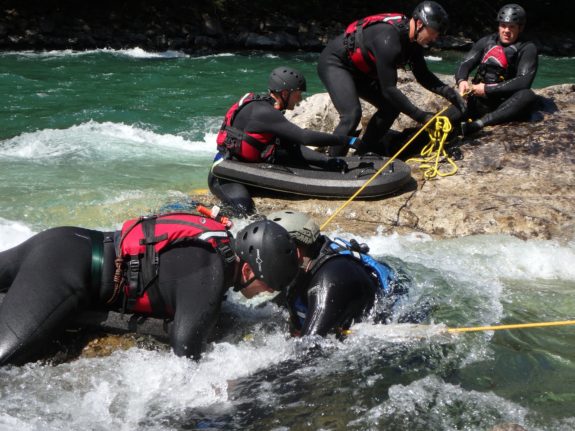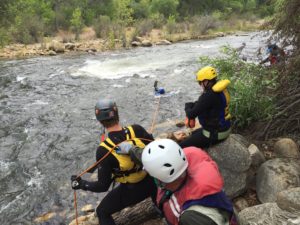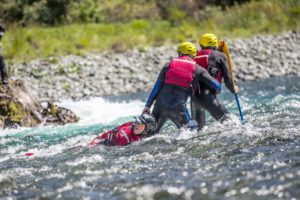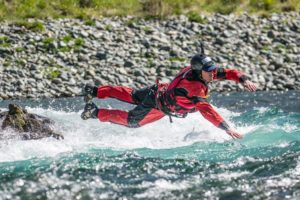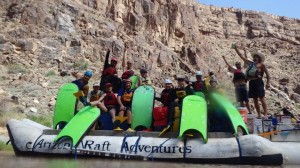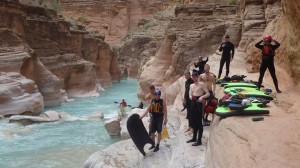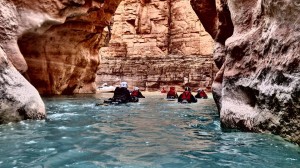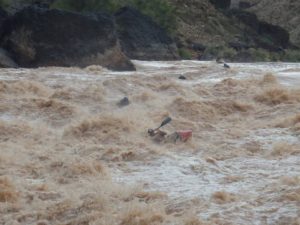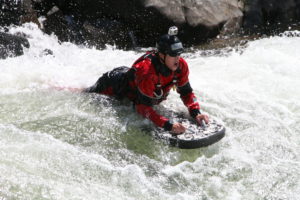Every year, I have the pleasure of working with the US Border Patrol Swiftwater Rescue Instructors. We concentrate on improving teaching techniques, getting out on the water together, and being sure to all stay on the same page. BORSTAR, like the National Park Service, and may other SAR teams, commonly use river boards as rescue tools and adjuncts. During the above mentioned BORSTAR training, 4 of us were able to execute the rescue of a solo kayaker; cold, lonely, scared, and stranded on the opposite side of a 48 degree river. He was stranded due to a swim at a roadside paddling spot, late in the day, and underestimating both the water temp and the speed of the water. With our river boards, we were able to complete the “rescue” in about 7 minutes. One board for the swimmer, one board to tow the kayak, one board to keep an eye on things, and one board to retrieve the paddle. Within minutes, he was warming up in his car, and his kayak was secured back on his roof.
The beauties of the Carlson River Board include the quick learning curve, the soft surface, the 160 pounds of flotation, the extra handles, and the durability. It is quick and easy to deploy, and makes a great access tool, if even just to gain a better understanding of the circumstances, or have a conversation with the person in distress. We incorporate river boards into every Water course we do for Agencies, including the SRT and SRT-A, to be sure folks that have consistent swiftwater in their jurisdictions recognize this valuable resource is available.
So; why are they not in EVERY Swiftwater Rescue cache? Here are a couple misunderstanding about the boards.
REASON 1: FINS ARE EVERYTHING! The absolute worst thing that happened to the use of river boards was the so called: SAR fin. Success on a riverboard is all about having a fin that gives both power and steerage. The SAR fin provides NEITHER! Unless you are a lifeguard who can paddle or kick with any hindrance, the SAR fin is just a sea anchor in the water. Normal people like myself, cannot go ANYWHERE with those fins on. The SAR fins are commonly used within Rescue Agencies because they “fit” over a boot, and then the riverboard gets the bad name! I hear comments like “riverboarding sucks” or “ I can’t get anywhere on the board” almost EXLCUSIVELY from folks that are using these fins. Take off your work boots, put on some hard soled booties, and some Churchill Fins (or equivalent) and your experience will completely change!
REASON 2: IT IS AN ADVANCED TECHNICIAN LEVEL SKILL: Yes, it is a water skill. It is a craft that can be used to accomplish NFPA 1670 2017 17.3.3, which requires a technician to perform a swiftwater rescue from a rescue platform. You must have the ability to self- rescue, and train with it as any other tool we have in our rescue cache. Learning to control and use a riverboard effectively can be much more practical, useful and achievable than gaining the extensive skill necessary to control a boat. It is a craft that is best operated “un-tethered”. Rope drag in the water only makes it more difficult to navigate. Most rescues should be done rope free. With proper training, and a thorough knowledge of what is downstream, the river board is easy to paddle out, extend as an adjunct, and kick on the board with the victim, or kick back to shore towing the victim. It is a tool that is best used in its “simplest” form. This is not to say it cannot be tethered, and used to pendulum someone off of a car, or mid channel obstacle; but access is most likely best accomplished without the use of a rope.
I also have the pleasure of working with the Yosemite SAR Rangers each year. Many of their “rescues” are simple “assists” due to the almost exclusive use of river boards when it is safe to access. The great thing about a river board is that it can be deployed from almost anywhere. No boat ramps needed! Almost all of the actual rescues I have been involved in over the past few years have also involved using a river board. From assisting non-swimmers back to shore who have fallen out of an inner tube, or commercial raft, to accessing an island with someone stuck in a strainer. These have all been simple assists due to the efficiency and effectiveness of the river board.
You don’t hear much about river board rescues because by the time someone shows up with a camera, or a go-pro, the rescue is complete! ~Julie Munger


